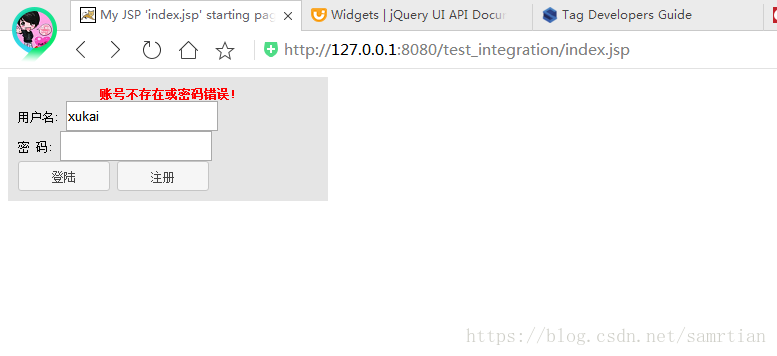首先加入
json需要的包: struts2的包不用说了当然得加入了

struts.xml配置信息
<?xml version="1.0" encoding="UTF-8" ?>
<!DOCTYPE struts PUBLIC
"-//Apache Software Foundation//DTD Struts Configuration 2.5//EN"
"http://struts.apache.org/dtds/struts-2.5.dtd">
<struts>
<constant name="struts.devMode" value="true"/>
<constant name="struts.enable.DynamicMethodInvocation" value="true" />
<constant name="struts.ui.theme" value="simple" />
<!-- 这里继承的包是json,它里边继承了struts-default包所以就不用再继承了-->
<package name="login" namespace="/" extends="json-default">
<global-allowed-methods>regex:.*</global-allowed-methods>
<action name="logAction" class="com.test.action.LoginAction">
<!-- 因为用的是ajax所以成功的话我们在客户端判断跳转不跳转 -->
<!-- <result name="success">/LoginSuccess.jsp</result> -->
<result name="register">/Registeration.jsp</result>
<!-- 这里的类型要写成json,因为是用json来传数据的不用刷新网页. -->
<result type="json">
<param name="root">result</param>
</result>
</action>
</package>
</struts>Action的主要代码
package com.test.action;
import java.util.HashMap;
import java.util.List;
import java.util.Map;
import javax.annotation.Resource;
import javax.servlet.http.HttpServletRequest;
import org.apache.struts2.interceptor.ServletRequestAware;
import com.opensymphony.xwork2.ActionSupport;
import com.test.entity.User;
import com.test.service.UserService;
import net.sf.json.JSONObject;
@SuppressWarnings("serial")
public class LoginAction extends ActionSupport implements ServletRequestAware{
private UserService service;
private HttpServletRequest request;
private List<User> users;
private String result;
private Map<String,Object> map = new HashMap<String,Object>();
public String getResult() {
return result;
}
public void setResult(String result) {
this.result = result;
}
public UserService getService() {
return service;
}
@Resource
public void setService(UserService service) {
this.service = service;
}
@Override
public String execute() throws Exception {
// TODO Auto-generated method stub
String username = request.getParameter("name");
String password = request.getParameter("password");
map.put("msg", "账号不存在或密码错误!");
map.put("user", username);
User user = service.QueryUser(username);
if (user != null) {
if (user.getPassword().equals(password)) {
users = service.getAllUser();
map.put("msg", "success");
map.put("href", "Registeration.jsp");
}
}
JSONObject json = JSONObject.fromObject(map);
result = json.toString();
return SUCCESS;
}
public List<User> getUsers() {
return users;
}
public void setUsers(List<User> users) {
this.users = users;
}
public String registeration() {
String username = request.getParameter("name");
String password = request.getParameter("password");
if (service.exist(username)) {
request.setAttribute("MSG", "账号已存在!");
return ERROR;
}
User user = new User();
user.setName(username);
user.setPassword(password);
service.add(user);
return SUCCESS;
}
public String register() {
return "register";
}
@Override
public void setServletRequest(HttpServletRequest request) {
// TODO Auto-generated method stub
this.request = request;
}
public Map<String, Object> getMap() {
return map;
}
public void setMap(Map<String, Object> map) {
this.map = map;
}
}
这里用String格式化来传数据,其实也可以直接用Map来传,再配置文件里把result改成Action里的map变量就行.
jsp网页里的代码
<%@ page language="java" import="java.util.*" pageEncoding="GB18030"%>
<%@ taglib prefix="s" uri="/struts-tags" %>
<%@ taglib prefix="sx" uri="/struts-dojo-tags" %>
<%
String path = request.getContextPath();
String basePath = request.getScheme()+"://"+request.getServerName()+":"+request.getServerPort()+path+"/";
%>
<!DOCTYPE HTML PUBLIC "-//W3C//DTD HTML 5 Transitional//EN">
<html>
<head>
<base href="<%=basePath%>">
<title>My JSP 'index.jsp' starting page</title>
<meta http-equiv="pragma" content="no-cache">
<meta http-equiv="cache-control" content="no-cache">
<meta http-equiv="expires" content="0">
<meta http-equiv="keywords" content="keyword1,keyword2,keyword3">
<meta http-equiv="description" content="This is my page">
<!--
<link rel="stylesheet" type="text/css" href="styles.css">
-->
<link rel="stylesheet" href="jquery1.12/jquery-ui.css">
<script src="jquery1.12/external/jquery/jquery.js"></script>
<script src="jquery1.12/jquery-ui.js"></script>
<sx:head/>
<style type="text/css">
div,body,td,span {
font-size: 12px;
}
form {
padding: 0px;
margin: 0px;
}
.div {
padding: 10px;
width: 300px;
background-color: #E5E5E5;
}
#errorDiv {
color: red;
text-align: center;
font-weight: bold;
}
</style>
</head>
<body>
<div class="div">
<div id="errorDiv" class="errorDiv"></div>
<form>
用户名: <input style="width: 148px; height: 24px; " id="name" type="text"> <br>
密 码: <input style="width: 148px; height: 24px; " id="password" type="password"><br>
<input type="button" id="loginBtn" value="登陆" style="width: 92px; height: 30px; ">
<input type="button" value="注册" style="width: 92px; height: 30px; " onclick="window.location.href='Registeration.jsp'">
</form>
</div>
<script>
// 加上$()这个符号是打开网页就直接运行
$( "input[type=submit], input[type=button]" ).button();
function bindBtl() {
$("#loginBtn").bind("click", function(){
// ajax的核心代码
$.ajax({
type : "post",
url : "logAction",
data : {
name : $("#name").val(),
password : $("#password").val()
},
dataType : "json",
success : function(data){
var d = eval("("+data+")");
if (d.msg == "success") {
window.location.href = 'LoginSuccess.jsp';
}else{
$("#name").val(""+d.user+"");
$("#password").val("");
document.getElementById('errorDiv').innerHTML = d.msg;
}
},
error : function(e){
alert(e.responseText);
}
})
})
}
// 这里手动运行一下上边的函数给按钮绑定事件
$(document).ready(function() {
bindBtl();
});
</script>
</body>
</html>






 该博客介绍了如何在Struts2.5框架下结合JQuery实现AJAX功能。通过配置struts.xml文件,设置Action代码以JSON格式返回数据,以及在JSP页面中编写相应的AJAX请求,实现页面无刷新的数据更新。
该博客介绍了如何在Struts2.5框架下结合JQuery实现AJAX功能。通过配置struts.xml文件,设置Action代码以JSON格式返回数据,以及在JSP页面中编写相应的AJAX请求,实现页面无刷新的数据更新。
















 129
129

 被折叠的 条评论
为什么被折叠?
被折叠的 条评论
为什么被折叠?








